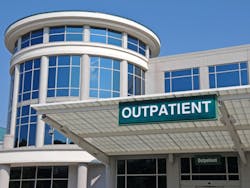Partners HealthCare Turns to Fuel Cells to Improve Electric Reliability at its Massachusetts Hospitals
Partners HealthCare, a medical network in New England, is moving forward with plans to install 4.1 MW of Bloom Energy fuel cells this year across its footprint of medical, healthcare, administrative and data center facilities in Massachusetts.
By Mark Winfrey/Shutterstock.com
“Partners intends to deploy the new systems at its corporate headquarters in Somerville, where more than 4,500 employees from administrative departments are based. They will also be deployed at North Shore Medical Center and Partners’ data center in Marlborough,” Partners’ Senior Manager, Energy & Sustainability Dennis Villanueva told Microgrid Knowledge.
The integrated healthcare systems signed a 15-year power purchase agreement with Bloom Energy for the fuel cells, primarily as a way to improve electric resiliency and reliability.
“Our hospitals and medical centers care for more than 1.5 million patients each year. Many of our facilities are open 24 hours per day, 365 days per year, so reliable electricity is both crucial to our operations, and one of our largest utility costs,” Villanueva said in an interview.
Power outages have not impacted Partners’ ability to operate to date, but Massachusetts suffered more than 100 power grid outages in 2017 lasting a total of 55 hours, according to the Eaton Blackout Tracker. “In excess of 630,000 people were affected by the outages, more than a third of which were caused by bad weather and falling trees,” Villanueva said.
Fuel cells for health
Bloom Energy highlighted the human and environmental health benefits from fuel cells in a shareholder letter issued in February. “If the US health care system were considered a separate country, it would be the seventh-largest producer of carbon dioxide in the world. The opportunity to ‘decarbonize’ power generation and to safeguard patient care in the face of growing grid outages are significant priorities for the sector.”
Installing Bloom Energy Servers is in line with Partners’ commitment to enhance the overall sustainability of its operations and activities, Villanueva said. “Partners operates and considers a variety of on-site, distributed generation at all of their large facilities including solar, CHP/cogeneration, energy storage and fuel cells. We look at a variety of factors, including sustainability benefits, resiliency and cost savings to make sure we’re powering our facilities with clean, reliable and affordable energy.”
The fuel cells use natural gas and therefore produce less carbon dioxide than utility grid power. They also can run on renewable fuels like biogas and produce virtually no criteria air pollutants (e.g. regulations capping emissions of organic particulate matter).
Adding to the benefits, the fuel-cell systems use little water in normal operation.
Lower costs
Enhancing sustainability is a top organizational priority for Partners HealthCare. Finding ways to do so that make financial sense is the challenge.
The fuel cells qualify for credits under Massachusetts’ alternative portfolio standard, which enhances the project’s economics. The incentive program is like a renewable portfolio standard, but applies to clean energy resources that are not necessarily renewable.
“The healthcare sector utilizes energy at a far greater proportion than many others. We recognize that this trend is not sustainable, and we are working to reduce our impact on the environment. Bloom Energy allows Partners to take control of their energy economics. Partners now generates its own electricity at a lower and more predictable cost for the next 15 years,” Villanueva said.
Bloom Energy Servers up and running at Partners HealthCare’s Spaulding Hospital in Cambridge since the end of 2018 deliver electricity at a cost below what the facility had been paying for utility grid power, according to both parties.
Villanueva also pointed out that Partners is more than half-way towards achieving an organization-wide goal of reducing overall energy consumption 40 percent, thanks mainly to long-term power purchases and the execution of a master energy plan.
He also noted that Partners is a founding member of the Healthier Hospitals Initiative, a coalition of major health systems across the U.S. that have come together to improve sustainability and safety in healthcare.
Track news about use of fuel cells and other forms of distributed energy in healthcare. Subscribe to the free Microgrid Knowledge newsletter.







